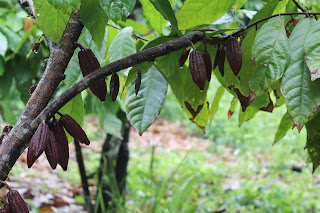
The main reason for coming to Jamaica was to visit a cocoa farm and meet the owner/farmer. Based on our experience, cocoa farms are never in the tourist areas or easy to get to places. Usually they are tucked away in some obscure valley over a yonder mountain range - or two. But that’s what makes it all the more challenging, intriguing and a little bit magical. Our goal is to bring our chocolate to every farmer that grows the cacao and thank them for all their hard work. In the fall, we will be coming out with a new single origin chocolate bar from Jamaica. We had the pleasure of meeting Desmond Jadusingh the owner, and spending the afternoon with him at his cocoa farm called Bachelor’s Hall.
What a delightful, knowledgeable and kind soul Desmond is. We connected with him immediately.

Driving thru Jamaica there are lots of signs that say “icy cold jelly.” These fruit stands are selling young green coconuts. Nothing quite quenches the thirst as drinking cold coconut water fresh from the coconut and then scooping out the cool jelly flesh. After our 4.5 hour drive to get to the farm Desmond greeted us with this treat. It was sooo good and hit the spot! I wasted no time digging in. The spoon to dig out the jelly coconut is a slice of husk cut right from the outside of the coconut.

Desmond took us on a walk about around his farm and showed us his operation. Here’s some beans being fermented. They are in a wooden box covered with banana leaves and burlap. Just love that yeasty smell of the beans at this stage.

Here’s the drying beds. After the beans have been fermented (usually 5 to 7 days, I believe Desmond does a 7 day ferment) they need to be properly dried. This can be really challenging in the tropical climate. Cocoa trees love the rain, but beans need dry weather. Desmond built his own tables for the beds from specific wood from his farm. Here we are turning the warm beans, heated by the sun,and mixing them up. This is where the love is put into the beans. It’s acutally quite meditative and therapeutic. This was my favorite part. I could have done this for hours.

Desmond has about 1000 acres. He grows both coconuts and cocoa together. Everything is organic and he works really hard to keep the balance in the land nurturing both these crops. We picked a cacao pod from the tree and got to taste the sweet fruit. I wish everyone got the chance to experience sucking the sweet fleshy pulp right from the pod. Theobromine - food of the gods.

Desmond also has a woodworking area where he makes all kinds of things from these huge trees on his land - doors, beds, fermenting boxes, etc. As he was showing us this area he told me it was a “no fly zone.” I didn’t know what he meant and he said, “Oh I specifically let all the spiders be. It keeps the flies away.” What the hell?! I then noticed all these HUGE spiders hanging everywhere!! Seriously, the biggest friggin’ spiders I have ever seen in my life. They were about the size of my hand. This was my least favorite part of visiting the farm. (Megan, Marlina, Rachael, Jessica - I hope you feel my pain).

More fun pics hanging around the cocoa farm. As we were leaving Desmond wanted to make sure we had a good journey back so he gave us lots of coconuts. Desmond is quite the success story. His cocoa beans have won awards and several European companies are vying for exclusive contracts to be the sole buyer of his beans. We feel so fortunate to have a supply and are looking forward to sharing our chocolate with everyone.
















































